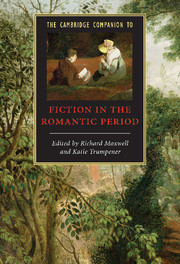Book contents
- Frontmatter
- Introduction
- 1 The historiography of fiction in the Romantic period
- 2 Publishing, authorship, and reading
- 3 Gothic fiction
- 4 The historical novel
- 5 Thinking locally: novelistic worlds in provincial fiction
- 6 Poetry and the novel
- 7 Orientalism and empire
- 8 Intellectual history and political theory
- 9 Women writers and the woman’s novel: the trope of maternal transmission
- 10 Tales for child readers
- 11 Sentimental fiction
- 12 Fiction and the working classes
- 13 The Irish novel 1800-1829
- 14 Scotland and the novel
- Further reading
- Index
- Series List
14 - Scotland and the novel
Published online by Cambridge University Press: 28 January 2009
- Frontmatter
- Introduction
- 1 The historiography of fiction in the Romantic period
- 2 Publishing, authorship, and reading
- 3 Gothic fiction
- 4 The historical novel
- 5 Thinking locally: novelistic worlds in provincial fiction
- 6 Poetry and the novel
- 7 Orientalism and empire
- 8 Intellectual history and political theory
- 9 Women writers and the woman’s novel: the trope of maternal transmission
- 10 Tales for child readers
- 11 Sentimental fiction
- 12 Fiction and the working classes
- 13 The Irish novel 1800-1829
- 14 Scotland and the novel
- Further reading
- Index
- Series List
Summary
Scottish fiction, meaning at once fiction produced in Scotland and fiction that made Scotland its topic, became one of the leading genres of European Romanticism in the decade after Waterloo. Its distinctive forms, the three-volume historical novel, magazine tale and fictitious regional memoir, were the product and fuel of a spectacular Edinburgh publishing boom in the first quarter of the nineteenth century, which was also characterized by innovations in the periodical genres of quarterly review and monthly magazine. The proportion of British fiction titles produced in Scotland rose steeply from a mere 0.5 percent in the first decade of the century to 4.4 percent in the 1810s and then to 12 percent in the 1820s, reaching 15 percent, or 54 out of 359 titles, in the peak years of 1822-5. Following a nationwide financial crash in 1826, booksellers cut back the production of new novels, especially in Scotland, and invested instead in miscellanies, serials, reprints, and the genres of “useful knowledge.” “Our publishers of the proud northern metropolis seem to have lost all pluck since the lamented death of their great father, Mr Constable,” remarked Fraser's Magazine in 1830: “the vaunted Modern Athens is fast dwindling away into a mere spelling-book and primer manufactory.”
The meteoric career of Scottish fiction, as everyone at the time acknowledged, traced the career of an individual author, Walter Scott. The publication of Waverley in the summer of 1814 accelerated a modest rate of growth into a regional bonanza.
- Type
- Chapter
- Information
- The Cambridge Companion to Fiction in the Romantic Period , pp. 251 - 264Publisher: Cambridge University PressPrint publication year: 2008
- 1
- Cited by



